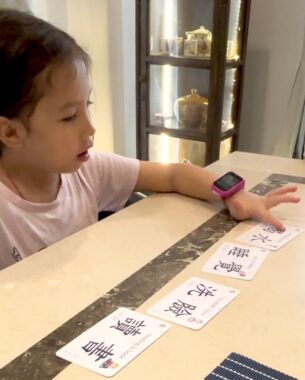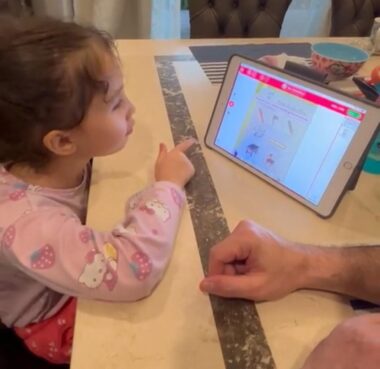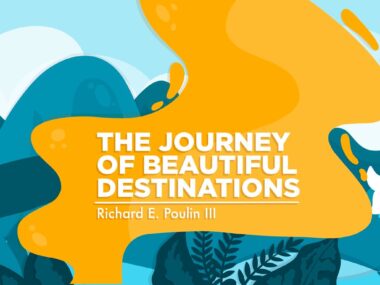Learning new languages opens a world of possibility for our daughter
Multilingualism aids in her cognitive development and brings her joy
Written by |

My wife, Judy, and I have spent our careers teaching at bilingual schools, where the curriculum is delivered in at least two languages and all students are expected to learn in both of them. We’ve always believed in the cognitive benefits of bilingualism, such as enhanced problem-solving, creativity, and improved memory.
Long before our daughter, Rylae-Ann, was born, we knew we wanted to raise her in a similar learning environment to harness these advantages.

Rylae-Ann works at the dinner table reading and speaking Chinese. (Photo by Richard E. Poulin III)
However, our plans took a sharp detour when we discovered that Rylae-Ann was born with a rare disease called aromatic l-amino acid decarboxylase (AADC) deficiency. The dreams we had as parents vanished overnight, replaced with overwhelming fear and uncertainty.
AADC deficiency is a debilitating condition that left Rylae-Ann unable to control her muscles. She frequently suffered from oculogyric crises that twisted her body every few days. Her muscle tone was so poor that survival, let alone schooling, seemed like an insurmountable challenge. Our focus became keeping her alive and out of the hospital.
After her diagnosis and access to gene therapy treatment through a clinical trial, we found ourselves rethinking her future. We approached her development with a renewed sense of purpose, researching strategies to give her the best shot at cognitive growth despite her academic delay from years of immobility.
Diving right in
Introducing multiple languages early on became one of our strategies. Although it might seem counterintuitive to teach a child a second language while they’re still learning their first, research shows that young children have a remarkable capacity to learn languages. Bilingualism not only stimulates brain development, particularly in areas linked to executive function and multitasking, but it also helps with cognitive flexibility — a critical skill for children such as Rylae-Ann, who face developmental challenges.
Judy’s family is from Taiwan, and Rylae-Ann needed to learn Chinese to connect with them. During our visits there, the immersive environment helped her quickly absorb new Chinese words, reinforcing her language learning. Despite still mastering English, she also began developing the ability to speak and read in Chinese. Studies show that bilingual children tend to outperform monolingual peers in tasks that require divergent thinking, attention control, and even literacy, and we saw this reflected in Rylae-Ann’s progress.

Rylae-Ann pronounces and records her Thai vocabulary words on her iPad. (Courtesy of Richard E. Poulin III)
Today, Rylae-Ann can speak and read in both English and Chinese, easily switching between the two depending on whom she’s speaking with. Her language skills bring her joy, and she often giggles when I attempt to speak Chinese with her.
We live in Bangkok, so we also wanted her to learn Thai — not just to grasp the language, but also to appreciate the culture and traditions of our host country. Although we didn’t focus on her grades in Thai as we did with core subjects, we were astounded by her unexpected progress.
Last week, when she opened her Thai workbook, she began reciting the vocabulary words on the page without help. Judy and I were shocked! We had no idea she knew the words. We quickly grabbed the iPad to record the moment, capturing her saying all 10 vocabulary words flawlessly.
Bilingualism and multilingualism have done more than help her pick up languages; they’ve supported her cognitive development in unexpected ways. For Rylae-Ann, learning multiple languages has brought joy and empowered her development in ways we hadn’t anticipated.
Her journey reminds us of the transformative power of language learning and reaffirms our belief that with the right educational practices, her future remains bright and full of endless possibilities.
Note: AADC News is strictly a news and information website about the disease. It does not provide medical advice, diagnosis, or treatment. This content is not intended to be a substitute for professional medical advice, diagnosis, or treatment. Always seek the advice of your physician or other qualified health provider with any questions you may have regarding a medical condition. Never disregard professional medical advice or delay in seeking it because of something you have read on this website. The opinions expressed in this column are not those of AADC News or its parent company, Bionews, and are intended to spark discussion about issues pertaining to aromatic l-amino acid decarboxylase deficiency.






Leave a comment
Fill in the required fields to post. Your email address will not be published.